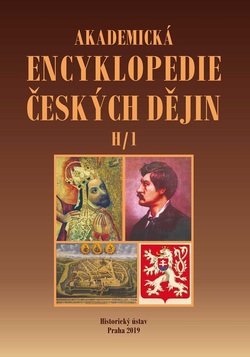Academic Encyclopaedia of the Czech History. Vol. V (H/1: Habans – Historicism)
 Year of publication:
2019
Year of publication:
2019
 Publisher:
Historický ústav
Publisher:
Historický ústav
 ISBN:
978-80-7286-339-6
ISBN:
978-80-7286-339-6

The Academic Encyclopaedia of Czech History is one of the most extensive works of contemporary Czech historiography. It is published by the Institute of History of the Czech Academy of Sciences and the individual entries are mainly prepared by its staff; some specialised entries are the work of historians, law historians, theologians and other leading experts in the humanities. The entries are divided into four categories according to the importance of the topic: A (± 45 000 characters), B (± 15 000 characters), C (± 5 000 characters), D (± 1000 characters). All entries are authorised and cross-referenced. The encyclopaedia focuses on the history of the Czech lands in the European and world context from the beginning of history to the present. It does not include personalities (the Biographical Dictionary of the Lands of Bohemia /Biografický slovník českých zemí/, published in parallel by the Institute of History of the CAS, is dedicated to them) or localities (the Lexicon of Historical Places of Bohemia, Moravia and Silesia /Lexikon historických míst Čech, Moravy a Slezska, 2001/, or its German version Handbuch der historischen Stätten. Böhmen und Mähren /1998/ deals with them).
The encyclopaedic entries are devoted to the following thematic areas: 1) territory: territorial, state-legal and structural-organisational development of the Czech lands (including the territories that were temporarily annexed to the Czech state); 2) population: nations, national minorities, ethnic groups on the territory of the Czech state, Czech minorities abroad, languages used in this environment; 3) society: social strata and groups, estates, social organisations, social issues, social movements; 4) economy: economic system, organizational forms, crises, monetary system, finance, taxation; 5) constitutional, administrative and legal system: state and governmental forms, ruling dynasties, institutions of legislative, executive and judicial power, authorities and their representatives; 6) politics: political power, its instruments and institutions, political movements, coups, revolts, uprisings, revolutions, political programs, associations and parties, manifestos, affairs, etc. 7) international relations: foreign policy, diplomacy, peace conferences, treaties, bilateral relations, participation in international organisations; 8) military and warfare: the army and its components, military institutions, wars, battles, occupations, domestic and foreign resistance; 9) culture: cultural currents, branches, institutions, societies and associations, mass media, sport; 10) science and education: the development and organisation of education, universities, scientific institutions and organisations; 11) historiography: key terms of the field, historical sources, archives, museums, libraries, auxiliary historical sciences, history of historiography in the Czech lands and history of the Czech lands in foreign historiography, historical institutions, congresses, foreign centres of research on Czech history, didactics of history; 12) ideology: thought and ideological currents, myths and traditions; 13) religion: churches, church institutions, religious communities and trends, sects, heresies, confessions, reformation, recatholization, liturgy.
The Encyclopaedia pays balanced attention to all ethnic groups that have lived or live in the territory of the Czech lands, especially Czechs, Germans, Jews, Poles, and Roma, but also other, less numerous minorities.


